研究生硕士文献阅读与翻译整理
文献整理与研究 英语
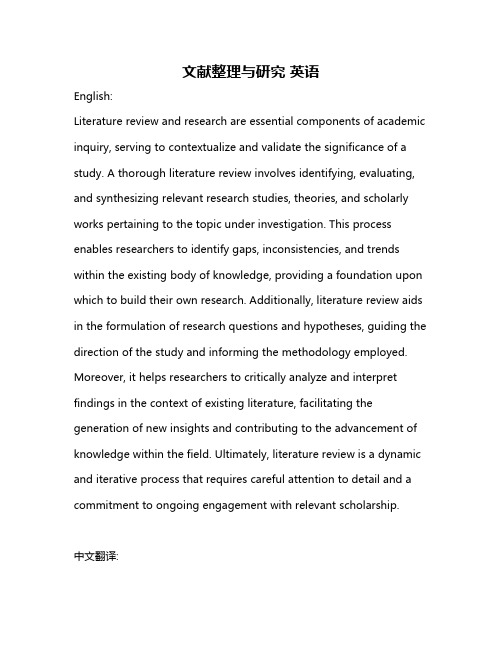
文献整理与研究英语English:Literature review and research are essential components of academic inquiry, serving to contextualize and validate the significance of a study. A thorough literature review involves identifying, evaluating, and synthesizing relevant research studies, theories, and scholarly works pertaining to the topic under investigation. This process enables researchers to identify gaps, inconsistencies, and trends within the existing body of knowledge, providing a foundation upon which to build their own research. Additionally, literature review aids in the formulation of research questions and hypotheses, guiding the direction of the study and informing the methodology employed. Moreover, it helps researchers to critically analyze and interpret findings in the context of existing literature, facilitating the generation of new insights and contributing to the advancement of knowledge within the field. Ultimately, literature review is a dynamic and iterative process that requires careful attention to detail and a commitment to ongoing engagement with relevant scholarship.中文翻译:文献综述与研究是学术探究的重要组成部分,有助于为研究的意义提供背景和验证。
Unit2文献阅读与翻译第二章
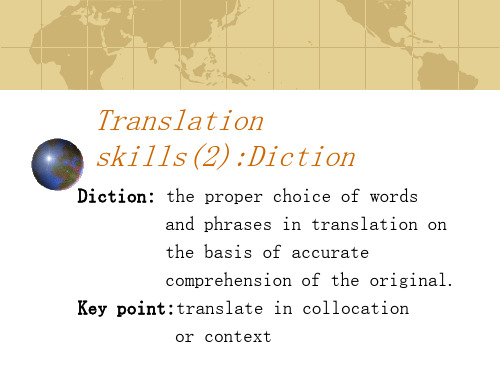
Eg.1:Tension is building up.
形势紧张起来。 张力在增大。 电压在增加。 压力在增强。 ……
Eg.2: the English word of story
This war is becoming the most important story of this generation. (事件) It is quite another story now, for the leadership has changed. (情况) Some reporters who were not included in the session broke the story. (内情) A young man came to a police officer’s office with a story.
(3)Judging from the Context and Collocation
翻译硕士论文参考文献
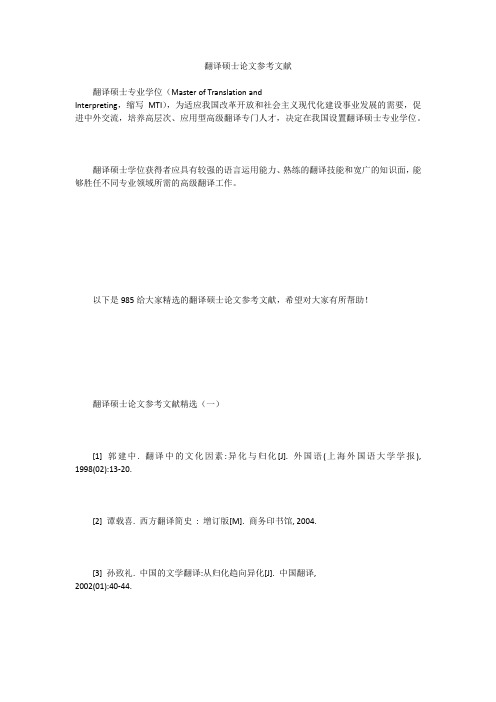
翻译硕士论文参考文献翻译硕士专业学位(Master of Translation andInterpreting,缩写MTI),为适应我国改革开放和社会主义现代化建设事业发展的需要,促进中外交流,培养高层次、应用型高级翻译专门人才,决定在我国设置翻译硕士专业学位。
翻译硕士学位获得者应具有较强的语言运用能力、熟练的翻译技能和宽广的知识面,能够胜任不同专业领域所需的高级翻译工作。
以下是985给大家精选的翻译硕士论文参考文献,希望对大家有所帮助!翻译硕士论文参考文献精选(一)[1] 郭建中. 翻译中的文化因素:异化与归化[J]. 外国语(上海外国语大学学报), 1998(02):13-20.[2] 谭载喜. 西方翻译简史: 增订版[M]. 商务印书馆, 2004.[3] 孙致礼. 中国的文学翻译:从归化趋向异化[J]. 中国翻译,2002(01):40-44.[4] 钱绍昌. 影视翻译--翻译园地中愈来愈重要的领域[J]. 中国翻译, 2000, 000(001):61-65.[5] 陈小慰. 翻译功能理论的启示——对某些翻译方法的新思考[J]. 中国翻译, 2000(4):9-12.[6] 许钧. “创造性叛逆”和翻译主体性的确立[J]. 中国翻译, 2003.[7] 胡庚申. 从术语看译论——翻译适应选择论概观[J]. 上海翻译, 2008, 000(002):1-5.[8] 李明编. 汉英翻译基础[M]. 上海外语教育出版社, 1998.[9] 张美芳. 翻译研究的功能途径[M]. 上海外语教育出版社, 2005.[10] 董晓波. 英汉比较与翻译[M]. 对外经济贸易出版社, 2013.翻译硕士论文参考文献精选(二)[1] 金惠康. 跨文化交际翻译[M]. 中国对外翻译出版公司, 2003.[2] 郭建中. 翻译中的文化因素:异化与归化[J]. 外国语(上海外国语大学学报), 1998.[3] 马祖毅. 中国翻译简史:"五四"以前部分[M]// 中国翻译简史:“五四”以前部分. 中国对外翻译出版社, 1984.[4] 张美芳. 功能加忠诚--介评克里丝汀·诺德的功能翻译理论[J]. 外国语, 2005.[5] AndréLefevere. Translation, rewriting and the manipulation of literaryfame = 翻译、改写以及对文学名声的制控[M]. Shanghai ForeignLanguage Education Press, 2004.[6] 李运兴. 字幕翻译的策略[J]. 中国翻译, 2001(04):38-40.[7] 孙艺风. 翻译研究与意识形态:拓展跨文化对话的空间[J]. 中国翻译, 2003, 024(005):4-10.[8] 许钧. "创造性叛逆"和翻译主体性的确立[J]. 中国翻译, 2003(1):8-13.[9] 蔡基刚. 重视大学英语翻译教学提高学生英语应用能力[J]. 中国翻译, 2003, 024(001):65-68.[10] 戴宗显, 吕和发. 公示语汉英翻译研究——以2012年奥运会主办城市伦敦为例[J]. 中国翻译, 2005(06):38-42.翻译硕士论文参考文献精选(三)[1] 熊兵. 翻译研究中的概念混淆——以"翻译策略","翻译方法"和"翻译技巧"为例[J]. 中国翻译, 2014, 035(003):82-88.[2] 孙致礼. 文化与翻译[J]. 外语与外语教学, 1999(11):41-42.[3] 霍斯特·弗伦兹, 金国嘉. 翻译的艺术[J]. 文艺理论研究,1982(01):155-164.[4] 顾宝珠, 黄子辉, 廉勇. 跨文化交际翻译[J]. 承德石油高等专科学校学报, 2015, 17(003):72-74.[5] 贾文波. 功能翻译理论对应用翻译的启示[J]. 上海翻译, 2007, 000(002):9-14.[6] 罗选民, 黎土旺. 关于公示语翻译的几点思考[J]. 中国翻译, 2006, 027(004):66-69.[7] 许建平, 张荣曦. 跨文化翻译中的异化与归化问题[J]. 中国翻译, 2002, 023(005):36-39.[8] 张新红, 何自然. 语用翻译:语用学理论在翻译中的应用[J]. 现代外语, 2001(03):285-293.[9] 潘文国. 当代西方的翻译学研究(续)——兼谈"翻译学"的学科性问题[J]. 中国翻译, 2002,023(002):34-37.[10] 基刚. 重视大学英语翻译教学提高学生英语应用能力[J]. 中国翻译, 2003, 024(001):65-68.。
硕士论文英文翻译
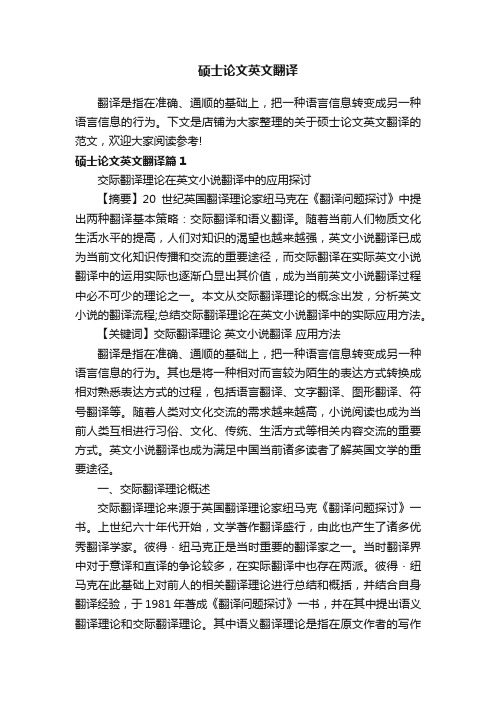
硕士论文英文翻译翻译是指在准确、通顺的基础上,把一种语言信息转变成另一种语言信息的行为。
下文是店铺为大家整理的关于硕士论文英文翻译的范文,欢迎大家阅读参考!硕士论文英文翻译篇1交际翻译理论在英文小说翻译中的应用探讨【摘要】20世纪英国翻译理论家纽马克在《翻译问题探讨》中提出两种翻译基本策略:交际翻译和语义翻译。
随着当前人们物质文化生活水平的提高,人们对知识的渴望也越来越强,英文小说翻译已成为当前文化知识传播和交流的重要途径,而交际翻译在实际英文小说翻译中的运用实际也逐渐凸显出其价值,成为当前英文小说翻译过程中必不可少的理论之一。
本文从交际翻译理论的概念出发,分析英文小说的翻译流程;总结交际翻译理论在英文小说翻译中的实际应用方法。
【关键词】交际翻译理论英文小说翻译应用方法翻译是指在准确、通顺的基础上,把一种语言信息转变成另一种语言信息的行为。
其也是将一种相对而言较为陌生的表达方式转换成相对熟悉表达方式的过程,包括语言翻译、文字翻译、图形翻译、符号翻译等。
随着人类对文化交流的需求越来越高,小说阅读也成为当前人类互相进行习俗、文化、传统、生活方式等相关内容交流的重要方式。
英文小说翻译也成为满足中国当前诸多读者了解英国文学的重要途径。
一、交际翻译理论概述交际翻译理论来源于英国翻译理论家纽马克《翻译问题探讨》一书。
上世纪六十年代开始,文学著作翻译盛行,由此也产生了诸多优秀翻译学家。
彼得・纽马克正是当时重要的翻译家之一。
当时翻译界中对于意译和直译的争论较多,在实际翻译中也存在两派。
彼得・纽马克在此基础上对前人的相关翻译理论进行总结和概括,并结合自身翻译经验,于1981年著成《翻译问题探讨》一书,并在其中提出语义翻译理论和交际翻译理论。
其中语义翻译理论是指在原文作者的写作中心出发,严格根据作者的写作思想及风格,对原文进行翻译,遵循“忠实性”原则。
语义翻译理论也更加注重原文的词语排序及语言表述,需尽可能贴合原著。
研究生毕业论文文献阅读与梳理

研究生毕业论文文献阅读与梳理研究生毕业论文是研究生阶段的重要学术成果,而文献阅读与梳理是撰写高质量论文的基础和关键。
通过系统、深入的文献阅读与梳理,研究生可以更好地把握研究方向,理清研究思路,提升论文的学术水平和研究深度。
本文将从文献阅读的重要性、文献梳理的方法和技巧以及如何有效进行文献综述等方面展开探讨。
一、文献阅读的重要性文献阅读是研究生进行科研工作的基础,也是研究生毕业论文写作的第一步。
通过广泛的文献阅读,研究生可以了解某一领域的研究现状、研究热点和前沿问题,找到自己感兴趣的研究主题,并确定研究的方向和目标。
此外,文献阅读还可以帮助研究生建立起扎实的理论基础,提高学术素养和研究能力,为撰写高水平的毕业论文奠定坚实的基础。
在文献阅读的过程中,研究生应该注重文献的质量而不是数量,选择与自己研究课题相关的文献进行阅读,深入挖掘文献中的观点、方法和结论,理解作者的研究思路和逻辑,积累相关领域的知识和经验。
同时,研究生还应该注重文献的更新性和权威性,及时关注最新的研究成果和学术观点,不断拓展自己的学术视野,保持学术的活力和创新性。
二、文献梳理的方法和技巧文献梳理是指对已阅读文献进行整理、归纳和总结的过程,目的是提炼出文献中的关键信息和观点,为撰写论文提供有力的支撑。
在进行文献梳理时,研究生可以采用以下方法和技巧:1.建立文献数据库:将已阅读的文献按照主题、作者、时间等分类建立数据库,方便查找和管理文献信息。
2.制定梳理计划:根据研究课题的要求和自身的研究方向,制定文献梳理的计划和目标,明确梳理的重点和内容。
3.筛选文献信息:对已阅读的文献进行筛选,挑选出与研究课题相关、内容丰富、观点新颖的文献进行梳理。
4.归纳总结:对选定的文献进行归纳总结,提炼出文献中的关键观点、结论和数据,形成清晰的梳理框架和逻辑。
5.撰写梳理报告:根据梳理框架和逻辑,撰写文献梳理报告,包括文献综述、研究现状、问题分析等内容,为后续的论文撰写提供参考。
文献阅读与翻译 Unit 1李
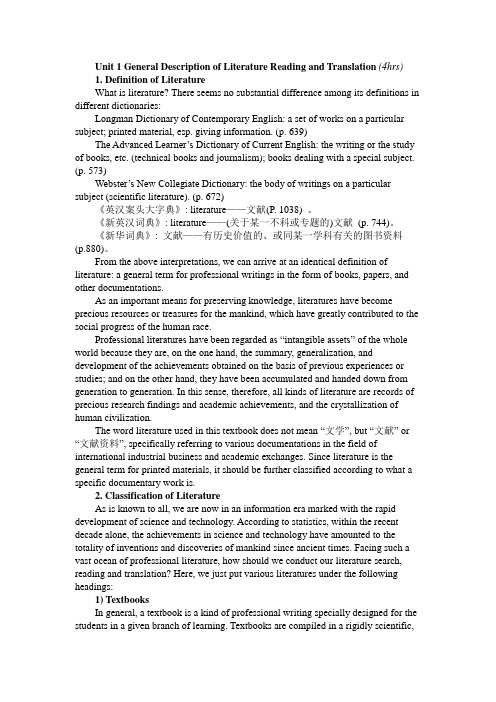
Unit 1 General Description of Literature Reading and Translation (4hrs)1. Definition of LiteratureWhat is literature? There seems no substantial difference among its definitions in different dictionaries:Longman Dictionary of Contemporary English: a set of works on a particular subject; printed material, esp. giving information. (p. 639)The Advanced Learner‟s Dictionary of Current English: the writing or the study of books, etc. (technical books and journalism); books dealing with a special subject. (p. 573)Webster‟s New Collegiate Dictionary: the body of writings on a particular subject (scientific literature). (p. 672)《英汉案头大字典》: literature——文献(P. 1038) 。
《新英汉词典》: literature——(关于某一不科或专题的)文献(p. 744)。
《新华词典》: 文献——有历史价值的、或同某一学科有关的图书资料(p.880)。
From the above interpretations, we can arrive at an identical definition of literature: a general term for professional writings in the form of books, papers, and other documentations.As an important means for preserving knowledge, literatures have become precious resources or treasures for the mankind, which have greatly contributed to the social progress of the human race.Professional literatures have been regarded as “intangible assets” of the whole world because they are, on the one hand, the summary, generalization, and development of the achievements obtained on the basis of previous experiences or studies; and on the other hand, they have been accumulated and handed down from generation to generation. In this sense, therefore, all kinds of literature are records of precious research findings and academic achievements, and the crystallization of human civilization.The word literature used in this textbook does not mean “文学”, but “文献” or “文献资料”, specifically referring to various documentations in the field of international industrial business and academic exchanges. Since literature is the general term for printed materials, it should be further classified according to what a specific documentary work is.2. Classification of LiteratureAs is known to all, we are now in an information era marked with the rapid development of science and technology. According to statistics, within the recent decade alone, the achievements in science and technology have amounted to the totality of inventions and discoveries of mankind since ancient times. Facing such a vast ocean of professional literature, how should we conduct our literature search, reading and translation? Here, we just put various literatures under the following headings:1) TextbooksIn general, a textbook is a kind of professional writing specially designed for the students in a given branch of learning. Textbooks are compiled in a rigidly scientific,systematic and logical way. Comparatively, the content of a textbook is mature and well established, because it has been compiled through the writer‟s careful selection, verification, discrimination, integration and comprehensive study of the subject. If you intend to acquire a general knowledge of a certain subject over a larger area, or if you want to have a preliminary understanding of a certain issue, you‟d better go over the relevant textbooks, which proves the best policy.2) MonographsA monograph is “an arti cle or short book on one particular subject or branch of a subject that the writer has studied deeply” (Longman Dictionary of Contemporary English, p. 704). It is also a “detailed scientific account, esp. a published report on some item of research” (The Advanced Learner‟s Dictionary of Current English, p. 632). The content of a monograph usually includes the history and present status of a particular subject, observed data, experimental methods and results, existing problems and the developing trend, various viewpoints and discussions of different schools of thought, research achievements and further exploration, and so on. A monograph usually functions as an important guide for the reader to understand the particular study comprehensively and deeply.3) PapersPapers are the most important and reliable sources for textbooks, monographs, and all the other documentary works. A complete paper is usually composed of the following elements: title, author, affiliation, abstract, keywords, introduction, theoretical analysis and/or experimental description, results and discussion or conclusion, acknowledgments, references, etc. (detailed description and exemplification of these elements in a professional paper are given in a separate textbook entitled Paper Writing and Publication, by Hu Gengshen, et al., Beijing: Higher Education Press, 2000.) A paper usually deals with a relatively specific topic, and with a comparatively narrow subject.4) EncyclopediasAn encyclopedia is “a book or set of books dealing with every branch of knowledge, or with one particular branch, in alphabetical order.” The difference between a dictionary and an encyclopedia is that “A dictionary explains words and an encyclopedia explains facts.” (Longman Dictionary of Contemporary English, p.361) As a basic reference book of generalized and summarized knowledge, an encyclopedia is usually compiled by many experts of many branches through many years. The contents of an encyclopedia, therefore, are comparatively mature and correct. It virtually serves as an important information retriever, providing comprehensive and systematic information about everything.The information retriever as such also includes yearbooks, dictionaries, guides, handbooks, and the like.5) PeriodicalsA periodical is a series of publications that appear at regular intervals. Periodicals are of various categories. From the perspective of names, for example, they are journals, acta, magazines, bulletins, rapid communications, letters, proceedings, records, abstracting services, reviews, indexes, etc., which constitute themain body of literature.Periodicals are characterized by being large in number and in variety, extensivein content and in circulation, mixed in language and in form, etc.Along with the rapid development of science and technology, periodicals have been rapidly increasing and have‟ been gradually professionalized, integrated and computerized.6) Special DocumentationThe so-called special documentation refers to all the printed materials that are non-books or non-periodicals. This special documentation mainly includes: standards, patent documents, trademarks, copyrights, contracts/agreements, reports, conference papers, dissertations (or theses), Product specifications, government publications, proposals, technical archives, electronic hypertexts, etc. Though neither books nor periodicals published regularly or publicly, the special documentation proves to be most effective resources for information retrieval. Insofar as literature search and reading are concerned, this kind of special documentation should not be overlooked. On the contrary, it calls for our special attention--that is why we have placed special emphasis on special documentation in the present textbook.Notes:1. journals, Acta, magazines, bulletins, rapid communications, letters, proceedings, records, abstracting services, reviews, indexes, etc. 会刊,学报,杂志,通报,快讯,通信稿,会议录,文献记录,世界文摘服务,评论,索引等2. hypertext 超级文本(指信息高速公路上的文件)3. Linguistic Features of Scientific LiteratureStylistically, literature is a kind of formal writing. Compared with an informal writing which usually utilizes an informal tone and colloquial language, a formal writing is a more serious approach to a subject of great importance and it avoids all colloquial expressions. Since the functions of scientific literature are to reveal creative research achievements, facilitate professional information retrieval, and help improve the development of science and technology, it deals objectively with the study of facts or problems; analyses on literature are based on relevant data, not on personal feelings, and discussions or conclusions are made on the basis of specific experiments or investigations.Syntactically, scientific literature has rigorous grammatical structures, and in most cases is rather unitary. Frequently used are indicative sentences, imperative sentences, complex sentences, and “It be + adj. (participle) + that ...” sentence patterns, etc.Morphologically, scientific literature is featured by high specialization, the use of technical terms and jargons, unambiguous implication and the fixed sense of the word. There are more compound words, Latin and Greek words, contracted words, noun clusters and so on in scientific literature than in other informational writing.Besides, non-verbal language is also very popular in various literatures such as signs, formulas, charts, tables, photos, etc. for the sake of accuracy, brevity, and clarity.Different literatures may have different linguistic features although they do havesimilar characteristics in common. The linguistic features of an individual literature will be discussed together with the specific category of documentation in the corresponding Unit of this textbook. To learn the linguistic features of various literatures will be beneficial not only to documentation reading but also to the translation and writing of such documentary works.4. Search for Relevant LiteratureThe search for relevant literature needed for professional study and research has become a practical skill for professionals. This is important because an effective way of literature search and reading will facilitate our information retrieval within a shorter period of time. In fact, everyone may have his/her own way of literature search and reading. And the following are some usual approaches:1) Global SearchBy “global search” we mean to search for materials around the subject in a larger dimension or within a wider range, i.e., conducting the extensive reading. For example:(1) Search for relevant books through the Classified and Specified Catalogues.(2) Search for periodicals through the Newspapers and Journals Indexing.(3) Search for domestic literature through the Domestic Sci-tech Data Catalogues.(4) Search for current foreign literature through the Sci-Tech Translation Bulletin.(5) Search for literature at home and abroad through INTERNET, WWW (World Wide Web), and other electronic retrieval means.2) Specific SearchBy “specific search” we mean to search for literature about a certain topic withina specific area or in a narrower scope. For example:(1) Select some most-related papers for intensive reading.(2) Expand the scope of the reading only on the basis of the references of the selected papers.(3) Try to find out relevant “reviews” on the topic so as to know the authoritative comments, the experts‟ views, the global developing trend and the general on-goings, etc.3) Processed SearchBy “processed search” we mean to accumulate and absorb essential information in the course of literature search and reading. For example:(1) Store the searched literature by careful note-taking and self-abstracting.(2) Sort out the searched documentation by timely putting them into different categories.(3) Digest/Absorb the searched information by creatively analyzing and synthesizing.It is very important to identify and then make generalization of the essential parts of the research papers, because the author of a paper should and must present his/her achievements or research findings through these parts. For this purpose, as a researcher, one has to be good at doing retrieval reading. By retrieval reading wemean retrospect reading of the manuscript in a very careful way so as to identify, register and generalize the gist or the main parts of work, or contributions we have made in a given paper. Literally, we mean reading the manuscript in a thorough manner and making notes: (1) as to the subjects dealt with, particularly subjects concerning with new information given incidentally; and (2) as to the new result and conclusive ideas reported. Material relating to each subject should then be gathered together in a logical way; and (3) all the sentences generalizing the main ideas of all the original materials should be put together so as to be well-versed, abstract-brief, condensed, complete, yet easily readable.In the final analysis, to digest and absorb useful information is the ultimate purpose of literature search and reading. This is a process of discarding the dross and selecting the essential, eliminating the false and retaining the true, proceeding from the easy to the difficult and from the outer to the inner. It is also a process of reading, selecting, sorting, synthesizing, commenting, rationalizing, systematizing, reprocessing, etc.One thing that needs to be mentioned is that an awareness of information discrimination is highly necessary, for the collection and absorption of erroneous knowledge and information is harmful. Just as a western scientist says: “The fool collects data and the wise man selects them.” This remark, th ough drastic, is indeed philosophical.Notes1. through the Classified and Specified Catalogues 通过《分类目录或专题目录》2. through the Newspapers and Journals Indexing 通过《全国报刊索引》3. through the Domestic Sci-Tech Data Catalogues 通过《国内资料科技目录》4. Sci-Tech Translation Bulletin 《科技译文通报》5. the fool collects data and the wise man selects them 愚者采集资料,智者选择资料5. Review of this chapterDefinition of Literature: a set of works on a particular subject; printed material, esp. giving information; the body of writings on a particular subject (scientific literature)Classification of Literature: textbooks, monographs, papers, encyclopedias, periodicals, special documentation, etc.Linguistic Features of Scientific Literature: stylistically, a kind of formal writing, with rigorous and unitary grammatical structure, highly specialized and unambiguous wording for semantic accuracy, etc.Search for Relevant Literature: global search, specific search, and processed search Supplementary Readings on Informational Retrieval: retrieval system, microfilm, internet. database, reformat, on, e-mail, information infrastructure, information superhighwayTranslation Skills (1): Translation in General and Translation of Special LiteratureTranslation is a rendering of ideas or concepts from one language into another,i.e., the faithful representation in the target language of what is written or said in the original language.As a means of communication, translation plays an important role in human civilization. In the West, literary translation can be traced back to 300 BC; while in China, recorded translation activities are even earlier, dating from Zhou Dynasty (1100 BC). However, not until the recent centuries, especially by the end of the 19th century did systematic study of translation get under way. The recent decades have seen rapid development in translation theories and translation activities both at home and abroad.A modern society sees an extensive use of translation on various occasions. Proper and dexterous translation helps promote mutual understanding between peoples of different cultural and social backgrounds, whereas improper rendering of words or expressions leads to confusion. Take the ordinary word “menu” for example. Its original meaning is “a list of dishes in a meal or to be ordered as separated meals, esp. in a restaurant”, and the Chinese equivalent seems to be clear: 菜单. However, when it is used in computer science, its meaning shifts to “a list shown on the display of a computer from which a user can select the operation the computer is to perform.”Evidently the Chinese counterpart should be something like “选项、项目单” It is a pity that the initial translator neglected this definition, and as a result, this very popular term of computer science fails to convey its true meaning in Chinese--the translated term”菜单” sounds incongruous with its actual content. So is the rendering of “Renaissance”--commonly known as “文艺复兴” in Chinese. Although we know today that the movement extended far beyond the literature and art circle, and the connotation of “Renaissance” is much more profound than that of the Chinese term “文艺复兴”, yet it is generally accepted through common practice. Such improper rendering is not uncommon in Chines-English translation. A sweet and melodious trademark in Chinese, by improper translation, may cause uneasiness or even create a loathsome image in the mind of people of different social and cultural backgrounds. For example, a popular Chinese lipstick with the trademark “芳芳”, when transliterated into English as “Fangfang”, assumes a hideous image--the English word “fang” happens to have two disagreeable definitions: a, a long, sharp tooth of a dog; b.a snake‟s poisonous tooth. Consequently, this awkward transliteration has resulted in a complete failure in marketing. Similar translation blunders are not unusual in social or economic activities in our country. To name a few, translating “五讲四美、三热爱”into “five stresses, four beauties and three loves”, “抓紧施肥” into “grasp manure”, “街道妇女” into “street women”, “白酒”into “white wine”, etc. Had the translators had sufficient translation knowledge, such blunders would have been avoided.1. Nature and Scope of TranslationWhat is translation? Some people believe it is a science, others take it as an art; and yet many consider it a craft, or rather, a skill.Of these varied definitions, which one holds true for our purpose? The answer depends on how w e understand or interpret the word “translation”, for the very word “translation” itself is ambiguous. And the Chinese equivalent fanyi sounds even fuzzier. Fanyi, in Chinese, may either stand for a subject in the curriculum, a jobpeople engage in, a piece of literary work, or the translating or interpreting work itself. Sometimes, fanyi may even refer to the translator or interpreter himself/herself.If the word “translation” refers to a subject, namely, the study of translation theory and skills, it is no doubt a science, just as any subject is, with its own rules, laws and principles for the translators to observe; however, if it refers to some specific pieces of translation, then it is more like an art, with each piece of them manifesting its own charms and style in the creative hands of the translator; whereas, if it refers to a process, in which something is translated, then we may regard it as a craft or skill. For unlike any branch of natural science, the process of translation has its own nature, and none of its rules and principles are universally applicable. Therefore, it entails a lot of practice, and particular craftsmanship and skills are reflected by the touches of different translators.Translation covers a very broad range. In terms of languages, it can be divided into two categories: from native languages into foreign languages and vice versa; in terms of the mode, it can be divided into oral interpretation and written translation; in terms of materials to be translated, there are translation of scientific materials, translation of literary works such as novels, stories, prose, poetry, drama, etc., translation of political essays such as treatises on social problems, repons, speeches, etc., and translation of practical writing (as official documents, contracts and agreements, notices, receipts, etc.); in terms of disposal, it can be either full-text translation, abridged translation or adapted translation.2. Principles or Criteria of TranslationThe so-called principles and criteria of translation are actually the two sides of the same coin. That is, on the part of the translator, he or she should follow them while translating; whereas on the part of the reader or critic, he or she may use the principles and criteria to evaluate translation works. Whenever principles or criteria of translation are under discussion in China, Yan Fu‟s “three-character guide”--xin, da, ya, namely, “faithfulness (信), expressiveness (达), and elegance (雅)”, which was first proposed in 1898, would evoke controversy.In the past decades, Mr. Yan‟s principle has always been regarded as aplumb-line for measuring the professional level of translation and a goal for translators to strive after. However, in the application of this principle, people come to find some unsatisfactory aspects of the three-character guide and have put foreword a variety of new standards or criteria of translation.Despite a variety of opinions, two criteria are almost unanimously accepted by all, namely, the criterion of faithfulness/accuracy (忠实/准确) and that of smoothness (流畅). We may also take these two criteria as the principles of scientific literature translation. By faithfulness/accuracy, we mean to be faithful not only to the original contents, to the original meaning and views, but also to the original form and style. By smoothness, we mean not only easy and readable rendering, but also idiomatic expression in the target language, free from stiff formula and mechanical copying from dictionaries.3. Literal Translation and Free TranslationThe process of translation consists of two phases: comprehension and expression.Generally speaking, comprehension is of foremost importance, and expression is the natural consequence of thorough comprehension. However, in the practice we may find that now and then some words or phrases in their usual senses are very difficultto deal with because of the disparity between English and Chinese. In this case, we have to resort to some special means of translation. Literal translation (直译) and free translation (意译) are two dynamic approaches in dealing with such awkward situations.The so-called literal translation, superficially speaking, means “not to alter the original words and sentences”; strictly speaking, it strives “to keep the s entiments and style of the original.” It takes sentences as its basic units and takes the whole text (discourse) into consideration at the same time in the course of translation. Furthermore, it strives to reproduce both the ideological content and the style of the original works and retains as much as possible the figures of speech. There are quite a lot of examples of successful literal translation that have been adopted as idiomatic Chinese expressions. For example, crocodile‟s tears (鳄鱼的眼泪), armed to the teeth (武装到牙齿), chain reaction (连锁反应), gentlemen‟s agreement (君子协定), and so on. Similarly, some Chinese idioms also find their English counterparts through literal translation. For example, 纸老虎(paper tiger),一国两制(one country, two systems ), and so on.Free translation is an alternative approach which is used mainly to convey the meaning and spirit of the original without trying to reproduce its sentence patterns or figures of speech. This approach is most frequently adopted when it is really impossible for the translator to do literal translation. For example:Adam‟s Apple 喉结at sixes and sevens 乱七八槽It rains cats and dogs. 大雨滂沱Don‟t cross the bridge till you get to it. 不必担心过早。
江苏大学研究生文献阅读与翻译作业
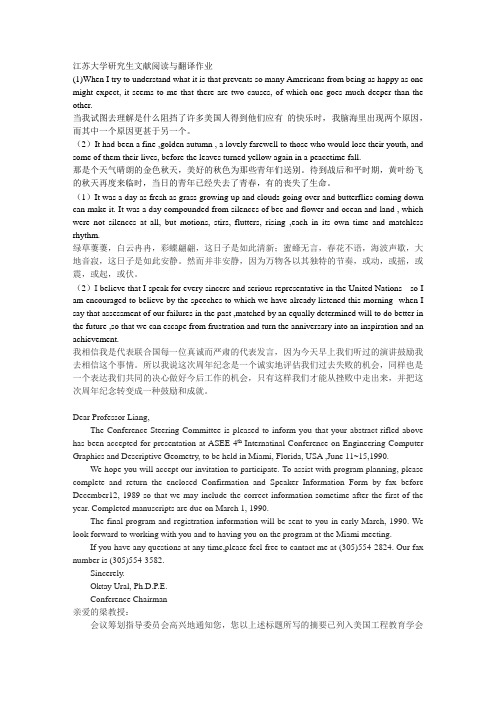
江苏大学研究生文献阅读与翻译作业(1)When I try to understand what it is that prevents so many Americans from being as happy as one might expect, it seems to me that there are two causes, of which one goes much deeper than the other.当我试图去理解是什么阻挡了许多美国人得到他们应有的快乐时,我脑海里出现两个原因,而其中一个原因更甚于另一个。
(2)It had been a fine ,golden autumn , a lovely farewell to those who would lose their youth, and some of them their lives, before the leaves turned yellow again in a peacetime fall.那是个天气晴朗的金色秋天,美好的秋色为那些青年们送别。
待到战后和平时期,黄叶纷飞的秋天再度来临时,当日的青年已经失去了青春,有的丧失了生命。
(1)It was a day as fresh as grass growing up and clouds going over and butterflies coming down can make it. It was a day compounded from silences of bee and flower and ocean and land , which were not silences at all, but motions, stirs, flutters, rising ,each in its own time and matchless rhythm.绿草萋萋,白云冉冉,彩蝶翩翩,这日子是如此清新;蜜蜂无言,春花不语,海波声歇,大地音寂,这日子是如此安静。
研究生科技英语阅读课文翻译(1-10).
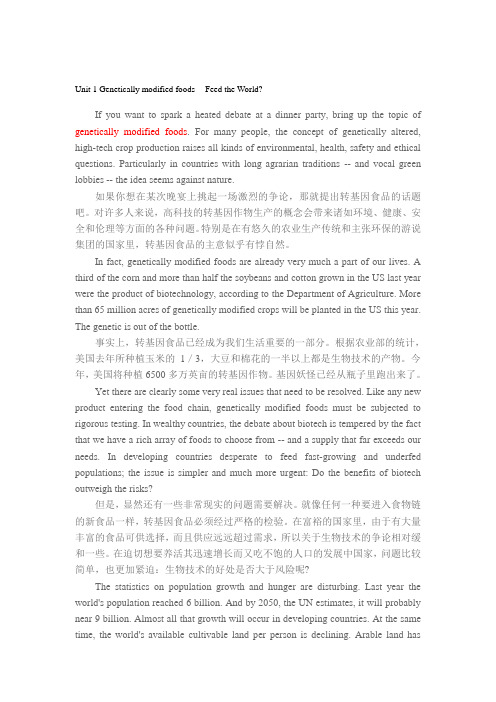
Unit 1 Genetically modified foods -- Feed the World?If you want to spark a heated debate at a dinner party, bring up the topic of genetically modified foods. For many people, the concept of genetically altered, high-tech crop production raises all kinds of environmental, health, safety and ethical questions. Particularly in countries with long agrarian traditions -- and vocal green lobbies -- the idea seems against nature.如果你想在某次晚宴上挑起一场激烈的争论,那就提出转基因食品的话题吧。
对许多人来说,高科技的转基因作物生产的概念会带来诸如环境、健康、安全和伦理等方面的各种问题。
特别是在有悠久的农业生产传统和主张环保的游说集团的国家里,转基因食品的主意似乎有悖自然。
In fact, genetically modified foods are already very much a part of our lives. A third of the corn and more than half the soybeans and cotton grown in the US last year were the product of biotechnology, according to the Department of Agriculture. More than 65 million acres of genetically modified crops will be planted in the US this year. The genetic is out of the bottle.事实上,转基因食品已经成为我们生活重要的一部分。
- 1、下载文档前请自行甄别文档内容的完整性,平台不提供额外的编辑、内容补充、找答案等附加服务。
- 2、"仅部分预览"的文档,不可在线预览部分如存在完整性等问题,可反馈申请退款(可完整预览的文档不适用该条件!)。
- 3、如文档侵犯您的权益,请联系客服反馈,我们会尽快为您处理(人工客服工作时间:9:00-18:30)。
2.1.Definition of professional papers• A professional paper is a typewritten paper in which professionals present their views and research findings on a chosen topic.2.2.Classification of professional papers1)Report PaperThe report paper summarizes and reports the findings of another on a particular subject. The writer neither judges nor evaluates the findings, but merely catalogs them in a sensible sequence2) Research paperA research paper can be intelligent, well informed, interesting, and original in its conclusions.3) Course Papercourse papers are written after a specific course is learned or are designed at the end of a term. This type of paper is, therefore, also called “term paper”.4) Thesis Paperthe thesis paper takes a definite stand on an issue. A thesis is a proposition or point of view that a writer or speaker is willing to argue against or defend. A paper that argued for ratification of a certain event would therefore be a thesis paper. Writing a thesis paper requires a writer to exercise judgment, evaluate evidence, and constructa logical argument, whereas writing a report paper does not2.3. Linguistic Features of Professional Papers1) Formal StyleA professional paper deals with the study of some objective facts or problems, and the conclusion that is drawn should be based on relevant data, not on personal likes and dislikes.It is particularly important in any kind of scientific inquiry; it does not matter who is conducting the experiment or investigation. Being impersonal and free from emotional factors is one of the important features in professional writing.The need to be formal comes from the fact that science reflects the objective facts, and it is free from bias and prejudice. The need for objectivity becomes a matter of special concern whenever a research or investigation touches upon human actions or attitudes.2) Specialized Terms(自行举例)The terms in professional papers are typically specialized.Take the word “normal” as an example. Generally, it means “正常”; but in mathematics, it represents “法线”; and in the field of chemistry, “当量” Again the word “power.” In electronics, it is rendered as “电力” or “电源”; in mechanics, “动力”; whereas in mathematics, “幂”Even in the same field, the meanings of the same word may vary slightly due to its different collocations.•filter 滤波器, 滤色器tramp filter 干扰滤除器•amplitude filter 振辐滤色器filter paper 滤纸•primary filter 基色滤色器What is more, a great number of professional words and terms can only be understood by the specialists in the fields.decoder (译码器), photophor (磷光核), multi-quantum transition (多量子跃迁), Read Only Memory (只读储存器) and conversational implicatures (会话含义),Unit 4Abstracts4.1. Definition of AbstractsAn abstract is a brief and self-contained summary and an accurate representation of the contents of a document such as a research paper, a journal article, thesis, review, conference proceeding, and other academic documents.4.2. Classification of AbstractsIt can be a description of what kind of information it is, which includes the purpose, scope, and methods of the research or it can be the informative content of the document,which includes results and conclusions of the research.如何分类:Depending on which information they contain,abstracts can be classified into major types:indicative abstract informative abstracts,indicative-informative abstract and author abstracts. As they have different aims ,they have different components and styles,4.2.1. Indicative (or descriptive abstracts)An indicative abstract or descriptive abstract is one that describes the type and nature of the work abstracted, indicating the principal subjects covered and providing a brief description of the way the facts are treated and the methods or techniques that are being reported.4.2.2. Informative abstracts4.2.3. Indicative / informative abstracts (综合性)Indicative/ informative abstract is more common than either the pure indicative or the pure information style.4.2.4. Author abstract4.2.5. Slanted abstract4.2.6. Telegraphic abstract4.2.7. Mini-abstract4.2.8 Mission-oriented abstract4.2.9 Finding-oriented abstract4.2.10 Highlight abstract4.3.Linguistic Features of Abstracts4.3.1 Using Topic, Supporting, and Concluding Sentences•An abstract often starts with a “topic” or “lead” sentence. This first sentence attempts to summarize any essential information that is not conveyed by the title. The objective is to enable the reader to eliminate possibly relevant documents, which, in fact, prove to be of little interest without delving into the body of the abstract.4.3.2 Using Brief but Informative SentencesThe abstractor must resist the temptation to use long sentences in striving to avoid repetition.4.3.3 Arranging in One ParagraphAll abstracts, barring possibly those of exceptional length, should consist of one paragraph only. This should be a coherent paragraph, and not a series of disjointed sentences.4.3.4 Being ConciseConciseness is paramount. Redundant phrases such as: “the authors studied”, “in this work”, “the paper concludes by”, etc. should be avoided if possible.4.8. Translation Skills :Technical Terms4.8.1. Affixation•Affixation, which includes prefixation and suffixation, is an important means of coining English technical terms, with prefixes and suffixes as inseparable elements of the words being coined.4.8.2. CompoundingThe combination of two or more words to form a new word is called compounding. English technical terms formed by compounding generally take three forms: with a hyphen or without it, or two or more separate words.4.8.3. Blending•This is a variant of compounding, consisting in omitting the latter part of the first word and clipping off the first part of the second word. Sometimes, however, either the first part or the second part of the overlapped word may happen to be a full word.4.8.4. AcronymsBy acronym, we mean the formation of a word made up of the first letters of the name of something. Since it is very convenient to use this brief form, acronym emerges very frequently in English technical terms.4.8.5. Proper NounsMany of the technical terms in English are borrowed from proper nouns such as names of people, places, firms, trade marks, organizations, and so on. In such cases, consulting relevant dictionaries will be of great help.Unit 5Proposals5.1.Definition of ProposalA proposal is a suggestion or request that some particular action be taken. (A proposal is a written offer to solve a technical problem in a particular way, under a specified plan of management, or for a specified compensation.)三个要素:Tips: written offer to a solve technical problems, specified plan to management , and specified compensation are the main elements of proposal.5.2.Classification of Proposals• 5.2.1. Informal Suggestions• 5.2.2. Semiformal Proposals• 5.2.3 Formal Proposals5.3.Format of ProposalUnit 7Reviews7.1. Definition of Review:A review, as opposed to a survey, should be a critical summary, commentary and literally documented assessment of a work on a specific subject or in a particular field.7.2. Classification of Reviews1) Literature Review•Literature review is written on a particular subject (or a specialty) through analysis, study, synthesis, comment on the basis of extensively referencing professional materials both at home and abroad. It is a kind of comprehensive, summary and commentary article.2) Book Review•Book review is a kind of research writing, an article published in a newspaper or periodical that announces the publication of a new book. It tells what the book is about and evaluates it. The value of a book review depends on the knowledge and ability of the reviewer and on the reviewer's fairness in judging the book. For this reason, the reviewer should have a broad knowledge of the subject of the book under review, the ability to analyze a piece of writing, and the skills to communicate with the reader.7.3. Linguistic Features of Review1) General Contents of Book Reviews• A good book review is always within the scope of three elements: (1) it tells what the book is about, (that is to bring it to the attention of people who may not know of it or may not have considered it properly;) (2) it asserts a judgment of the book's worth,( that is to offer an assessment of its worth and usefulness; and) (3) it defends that judgment. Besides, some reviews undertake to familiarize the reader with the background of the book, (the history of the subject, or the context of issues the book is related to.)2) General Contents of Literature Reviews• A good literature review usually (1) includes the background, the prior work, present disputes, current development and prospect, etc. of the subject the review is about; (2) reveals the author's rigorous and objective comments; (3) provides the reader with a great number of references.只背画横线的部分即可,其他可作为理解。
